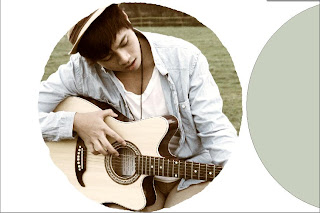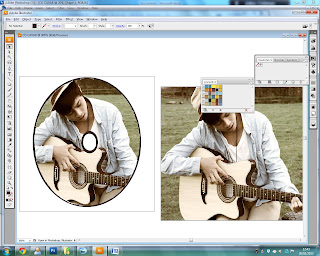The digipak I am analysing will be the indie-folk band "Momford and Sons". The group is seen in an extreme-long shot located at a village holding, what seems to be a festival. The atmosphere and mise-en-scene seen, emphasises the genre of the band. This is because Indie-folk is usually seen in a lot of festivals and concerts.
The background of the digipak is blurred, as everyone was moving around when the picture was taken. Furthermore three of the people in the group are looking directly at the camera whilst one of the group member is looking at person on his left. They don't have a specific pose, but casually sitting for the camera. This implies that everything happened in the moment, a picture that we could see a relation is from a festival or a party. This is to imply the idea of indie genre being individual or different from all other mainstream genres such as Pop or Rock music. In those genres stars would usually be portrayed in a specific pose or seen in an extreme-close up to promote the star in the image. The physical appearances of the stars are two group members in the middle are wearing formal clothing, whereas the other two are wearing casual clothing again, it implies the idea of the group member being different from each other hence indie, again Pop bands such as "Little Mix" They have some sort of style that are similar to each other.
The props that are seen in the digipak are flags: seen across the picture, junk and a horse on the far right, which is unusual for a CD cover, again suggesting that it does not entirely have to used specific props or any form of CGI to create the digipak used in mainstream music genres, which is common for a lot of genres, although with this digipak, it makes it more naturalistic and real as it is folk genre. The band of this image does not seem too dominant, they are more in the sense of selling their music rather seeing them as a particular star image. The digipak cover, make it seem that the band is aiming itself to a much more older audience, the age of 25-30 or above (or maybe a sub audience such as; teenagers that approach themselves to folk music)
The title of album is called
"Babel" which means
'A scene of a noisy confusion'. This immedietley becomes relevant to the digipak, by observing of what is happening at the back from the digipak, people are portrayed in a 'noisy' and a 'hazy' effect to create that sense of illusion of the festival being lively. The font of the band name is simple, although it resembles country genre a little because of the "&" and the "B", the style is rather old fashion and slightly elegant. The picture is in high key lighting to connote the happiness and joy of the atmosphere as well as giving a positive impulse towards the target user.
By Julius Conmigo























